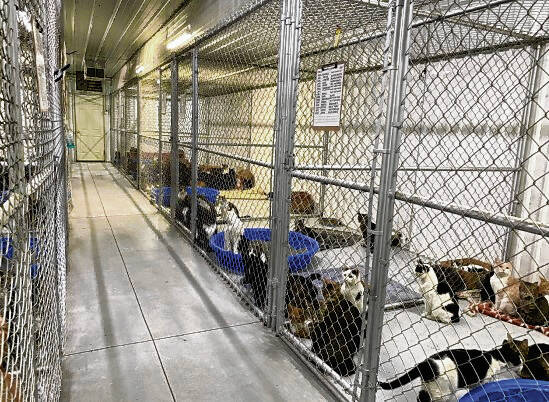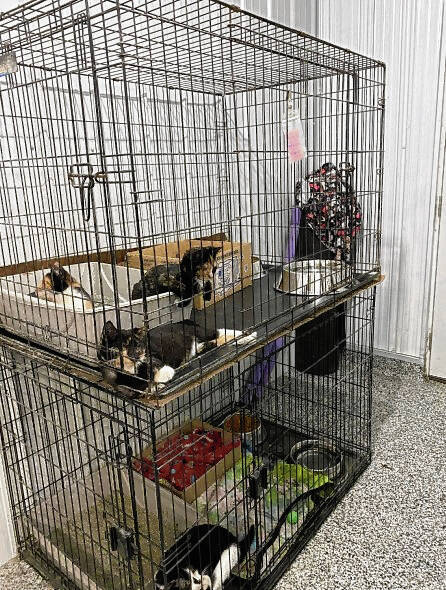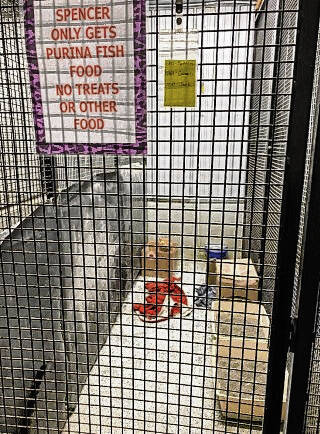
One of the rooms inspected at The Veterinarian’s Blood Bank in Vallonia after PETA made claims of neglect was occurring at the facility.
IBOAH | Dr. Jodi Lovejoy
By Erika Malone | Seymour Tribune
For The Republic
JACKSON COUNTY — Indiana State Board of Animal Health investigators have completed an inspection of The Veterinarian’s Blood Bank in Vallonia after allegations of neglect of cats and dogs from the animal rights organization, People for the Ethical Treatment of Animals (PETA).
PETA claimed more than 860 animals are living in poor conditions at the blood bank facility, accusing the company of producing tainted blood products from sick and injured animals.
The investigation began Nov. 30, 2023, following PETA’s complaint to state and local officials. PETA told The Tribune they gathered these claims and various photos and videos during an undercover investigation over a seven-month period last year.
Dr. Darren Bryant, veterinarian and co-founder of the Veterinarian’s Blood Bank, said the photos and videos PETA took are not accurate, stating that some of the photos are not from their facility and the video is edited in a negative image.
The Seymour Tribune was unable to independently verify PETA’s photos. Those used with the story were provided by the Indiana State Board of Animal Health through its investigation.
Inspection
According to the case report from the Indiana State Board of Animal Health following the investigation on Jan. 8, an unannounced inspection of the cat portion of the facility was completed by District 8 Field Veterinarian Dr. Jodi Lovejoy and Jessie Hutchinson, a Jackson County Sheriff’s Department detective.
Blood Bank Director Debbie Sweany and cat facility manager Natalie Wehmiller were present. During the inspection period, approximately 581 cats were present and evaluated.
The cats were evaluated using the Purina Cat Body Condition Scoring System, each on a scale from 1.0 to 9.0 with 5.0 being ideal fit. Additional measures included, the Feline Calculus Dental Score Chart, which score the accumulation of plaque on the teeth from 0 to 3, with a score of 0 to 1 being preferred.
Lovejoy reported all cats were observed, with most of the cats scoring in normal body conditions and only a small percentage scoring below average. Most of the underweight cats were located in the cat area, including one that was reported to be 16 years old.
Cats evaluated for calculus dental scores ranged from 0-2 and a small percentage of cats were noted to have ocular discharge, according to the report.
Prior to arriving at the facility, Hutchinson showed veterinary records to Lovejoy of two cats that were reportedly adopted from the facility earlier in the year. The cats were identified on the paperwork as Fox and Vivi.
PETA claims Fox had been suffering from bloody diarrhea and allegedly did not receive a veterinary exam or treatment until PETA’s investigator adopted the 13 year-old cat. After a few weeks, PETA reported Fox was euthanized after a veterinarian found he had gastrointestinal cancer.
In the report, it showed Fox was in normal body condition on presentation and his physical exam came back normal with no external or internal parasites observed.
Fox’s bloodwork, however, did show abnormalities, possibility indicating some type of infection. A radiograph determined Fox’s intestines were enlarged with gas and the veterinarian’s diagnosis at that time was possible irritable bowel syndrome.
Following another examination, Fox still had normal body condition, but had decreased by one “Body Condition Score” and was then euthanized.
PETA claims Vivi suffered from a mouth infection and was given dental treatment. The PETA investigator offered to adopt the cat, however, the manager allegedly refused the offer for months until they admitted the cat’s mouth condition had increasingly deteriorated.
The report showed Vivi’s was in normal body condition on presentation with no external or internal parasites observed, but was identified with dental disease. Vivi was reportedly given dental treatment involving pulling teeth.
Lovejoy noted the cats are group-housed unless there is a specific reason and reported one cat was housed individually due to being anti-social toward other cats. There are a total of six rooms, plus a quarantine area where some cats will be housed individually for treatment protocols if they have a disease.
Most of the primary enclosures were made of chain link kennel panels with some newer primary enclosures made of welded-wire panels all appearing to be in good condition with no rust noted. The enclosures contained large stuffed pet beds and blankets, plastic kiddie pools containing litter, food bowls and free-choice water.
PETA claims the facility crowded as many as 30 cats in pens that lacked adequate hiding places and activities. It also was alleged staff forced cats to compete for access to food, water perches and plastic kiddie pools of litter that were not cleaned on weekends.
In the report, Wehmiller said kennels are approximately 8-by-10-feet with approximately 15 cats per kennel. There is one main cleaning of the enclosures and litter boxes per day with spot cleaning as needed throughout the day, Monday through Saturday. Walls and floors are sanitized daily and the cats are moved to the aisle way while the enclosures are cleaned. On Sundays, a volunteer visits the facility and conducts a spot check. Lovejoy reported a slight ammonia order in Room 5, but it was barely detectable, according to the report.
Free choice dry food is available for all cats and soft food for young and senior cats with signs present on primary enclosures for some cats on special diets. Two food bowls are placed in the kennels on Saturdays and are washed once per week on Fridays with spot checks on other days of the week. Automatic water bowls are emptied once a day and sanitized throughout the week with spot checks on the weekends.
According to the report, cats are acquired by breeding in-house, from research facilities and from owner surrender, however, Wehmiller did mention an instance when an employee found a stray kitten and brought it to the facility.
PETA claimed the facility was acquiring cats seeking homes through online ads and newly arrived cats were kept in an outdoor shed to be tested for contagious diseases.
In the report, Wehmiller said new cats are tested for a wide range of infectious diseases and are kept in a quarantine area until their test results are known and completed a treatment protocol, if applicable. If a cat tests positive for a treatable condition the facility will treat the cat until cured and tested negative prior to being added to the blood draw rotation. If a cat is positive for an untreatable condition, it will either be returned to its owner, if possible, or euthanized.
Lovejoy noted a list of about 16 to 17 cats needing dental care present on a white board in the blood draw room and if a cat has severe gum issues, it is scheduled for dental work with Bryant, a veterinarian and co-founder of the facility. Cats have their nails trimmed, ears cleaned and are groomed when sedated for blood draws and cats that are not in the blood draw rotation are weighed monthly.
It was noted are eight employees working eight hours per day, Monday through Friday and one or two employees provide care on Saturdays.
According to the Journal of Shelter Medicine and Community Animal Health, a standard of 15 minutes per animal per day may be used to estimate the amount of time need for cleaning and feeding in a shelter. However, this does not consider other factors, such as facility design, quality time with animals and training of personnel.
Eight employees working 80 hours per day equals to 3,840 minutes per day not county employee breaks. With the facility group-housing cats Lovejoy said the amount of time required to clean and provide for the animals was expected to be significantly less than 15 minutes per cat.
Lovejoy observed during the inspection litter containers contained minimal feces, all feeders had clean food, water was available to all cats and the cat’s environment was free of excessive debris accumulation.
Blood draws
In the report, 50 ml of blood is collected from cats every three weeks and a cat’s blood regeneration time is around 14 days. The time between blood collection is shorter than the industry standard of eight weeks for client-owned donors and the facility’s blood standard is one week shorter than the International Society of Feline Medicine guidelines for clinic-owned cats, according to Lovejoy. Its standards, however, are in line with the blood banking proceeding in DVM 360, a well-known veterinary publication.
Prior to blood draws packed cell volume is checked and the cats are sedated during the procedure. Blood work is conducted if there appears to be a health issue, for first time donors or at least once per year.
The facility uses cats for blood draws from the time they reach 8 pounds until they reach 10 to 11 years of age with individual cats retiring soon based on circumstances. Male cats may reach 8 pounds and be used for blood draws as early as 9 months of age.
Lovejoy noted that the Veterinarian’s Blood Bank age range is significantly longer than the industry standard of one to eight years and also discussed with Dr. Ron Harrison, veterinarian and the other co-founder of the facility, about extending the time span between blood collections.
Bryant said the facility is very confident that the animals are not being harmed with the 21 day blood draws and will not be extending their time span.
“We do not draw the animals blood if they are low on B-12, iron or if they aren’t big enough and if they are low we give them supplements,” he said.
Bryant claims most of their animals are around 10 pounds allowing the animal to have a larger supply.
“We don’t want these animals to get sick and we are not gaining anything from deteriorating their health by drawing too much blood,” he said.
More to come
Indiana State Board of Animal Health Communications Director Denise Spears said an investigation into the dog portion of the facility is not yet completed.
The Jackson County Sheriff’s Department did not return calls seeking comment after multiple calls regarding their investigation into the neglect of two cats from the facility.
PETA claims PetVet Care Centers dropped The Veterinarian’s Blood Bank as a supplier to its veterinary hospitals. The Veterinarian’s Blood Bank also says it supplies blood to BluePearl Pet Hospital locations and VCA Animal Hospitals nationwide.
Bryant said the state inspection mentioned minor infractions such as a small portion of rust on one of the kennels and plaque accumulation on the dog portion of the inspection, but are working to take care of those recommendations.
“We are not trying to hide anything from our community and we have nothing to be ashamed of,” he said. ” We are providing a service for our veterinarian clinics that is going through a shortage.”








